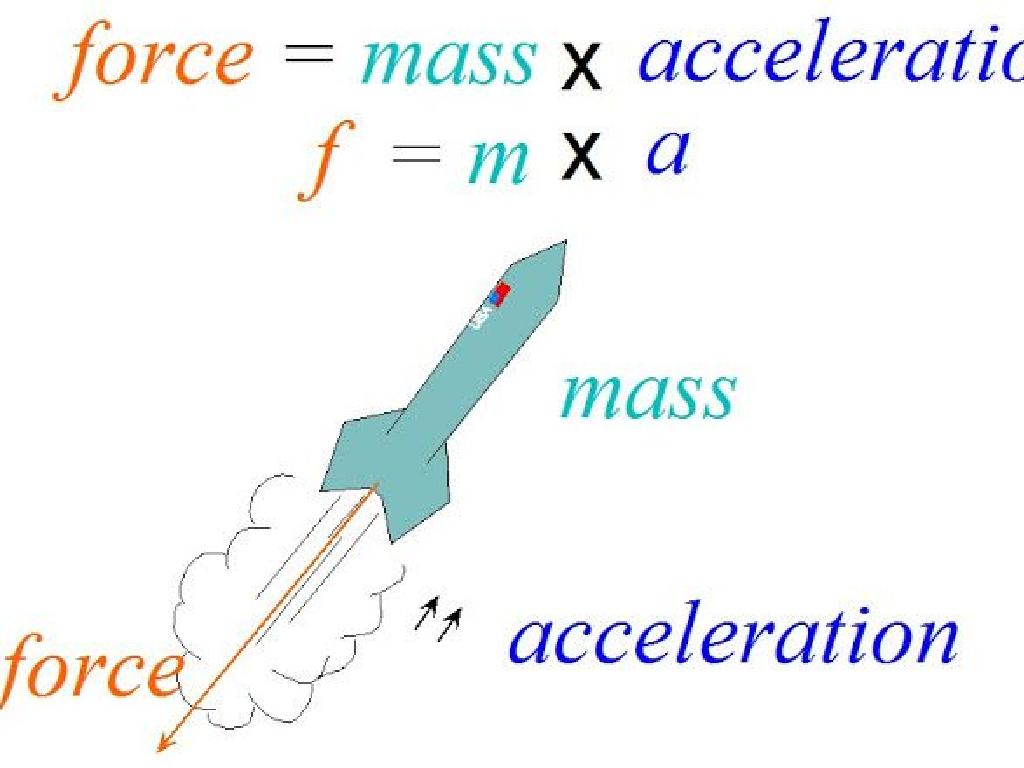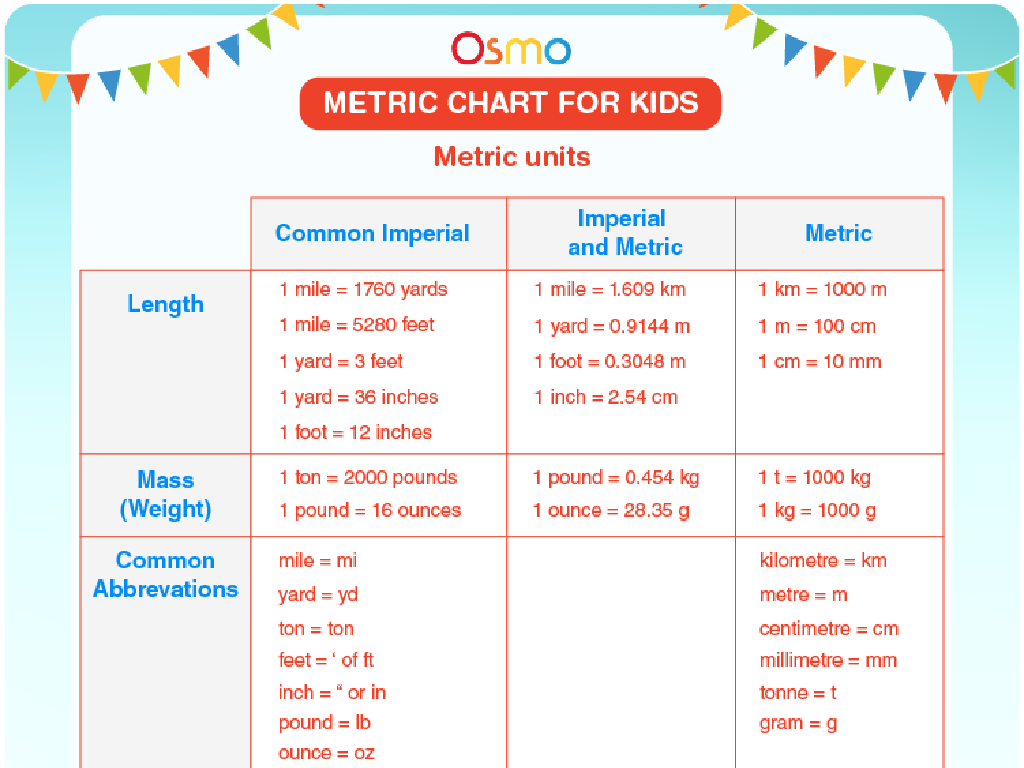Probability Of Independent And Dependent Events
Subject: Math
Grade: Seventh grade
Topic: Probability
Please LOG IN to download the presentation. Access is available to registered users only.
View More Content
Introduction to Probability
– Understanding chance in probability
– Probability measures the likelihood of an event to occur.
– Events: certain to impossible
– Certain: 100% chance, Impossible: 0% chance, Likely: >50% chance, Unlikely: <50% chance.
– Real-life probability examples
– Weather forecasts, winning a game, or getting a heads on a coin flip.
– Exploring likely & unlikely events
– A likely event has a greater chance than unlikely. E.g., rolling a number greater than 2 on a dice.
|
This slide introduces the concept of probability, explaining it as a measure of how likely an event is to occur. It’s important to clarify the difference between certain, likely, unlikely, and impossible events with clear definitions and probabilities. Provide relatable examples such as weather predictions or everyday games to illustrate these concepts. Encourage students to think of other examples of likely and unlikely events and discuss why understanding probability is useful in making predictions in various aspects of life.
Understanding Probability
– Define Probability
– Probability measures the likelihood of an event occurring.
– Probability range: 0 to 1
– It’s a scale where 0 means impossible, 1 means certain.
– Examples: Probabilities 0, 1/2, 1
– Impossible event: rolling a 7 on a die. Certain event: getting heads or tails when flipping a coin. 1/2 event: getting heads on a coin flip.
|
Probability is a fundamental concept in mathematics that quantifies the chance of an event happening. It is expressed as a number between 0 and 1, where 0 indicates an impossible event and 1 indicates a certainty. For example, the probability of rolling a 7 on a standard die is 0 (impossible), while the probability of getting either heads or tails on a coin flip is 1 (certain). A probability of 1/2 represents an event that has an equal chance of occurring or not occurring, such as getting heads on a single coin flip. Encourage students to think of other examples and understand that probability is a way to describe the uncertainty of events.
Probability: Independent Events
– Define independent events
– Two events are independent if the outcome of one does not affect the other.
– Calculating combined probability
– Multiply the probabilities of two independent events to find the likelihood of both occurring.
– Coin flip and die roll example
– Flipping a coin (1/2 chance) and rolling a die (1/6 chance) are independent; combined probability is 1/2 * 1/6.
– Independent events in daily life
|
This slide introduces the concept of independent events in probability, where the outcome of one event does not influence the outcome of another. Students will learn how to calculate the probability of two independent events occurring together by multiplying their individual probabilities. Use the example of flipping a coin and rolling a die to illustrate this concept, as these are classic examples of independent events. Encourage students to think of other examples from their daily lives where outcomes are independent of each other to solidify their understanding.
Probability of Independent Events
– Multiplication rule for independence
– If A and B are independent, P(A and B) = P(A) * P(B)
– Example: Flipping coins for heads
– Flipping a coin twice, getting heads both times: 1/2 * 1/2 = 1/4
– Practice: Probability of double sixes
– Rolling a die twice, getting six both times: 1/6 * 1/6 = 1/36
– Understanding event independence
|
This slide introduces the concept of independent events in probability, where the outcome of one event does not affect the outcome of another. The multiplication rule is a fundamental principle that calculates the probability of two independent events occurring together. For example, the probability of flipping a coin and getting heads twice is 1/4, since the probability of heads on a single flip is 1/2. As a practice problem, students will calculate the probability of rolling two sixes in a row with a standard die, which is 1/36. It’s crucial to emphasize that independence means the outcome of the first event does not influence the second event’s outcome.
Understanding Dependent Events in Probability
– Define dependent events
– Events where the outcome of one affects the probability of another
– Outcome influence between events
– Example: Cards without replacement
– Removing a card changes the probability of the next draw
|
Dependent events in probability are those where the outcome of one event has a direct effect on the outcome of another. For example, if you draw a card from a deck and do not replace it, the deck’s composition changes, thus affecting the probability of drawing a second card. It’s crucial for students to understand that in dependent events, the total number of outcomes can change, which is a key difference from independent events. Use the card example to illustrate how probabilities shift with each draw from the deck. Encourage students to think of other scenarios where outcomes are interlinked, such as picking teams for a game or selecting marbles from a bag.
Probability of Dependent Events
– Adjust probability with each event
– Example: Drawing cards in sequence
– What’s the chance of an ace, then a king from 52 cards?
– Practice: Picking two red marbles
– Find the chance of two red marbles from a bag, one after another.
– Understanding without replacement
– ‘Without replacement’ means the first item isn’t put back.
|
This slide focuses on understanding how the probability of dependent events is calculated. Dependent events are those where the outcome of one event affects the outcome of another. For example, when drawing cards from a deck, if you do not replace the first card, the total number of cards changes, which affects the probability of drawing the second card. The example provided should illustrate how the probability changes after the first card is drawn. The practice problem involves calculating the probability of picking two red marbles in a row from a bag, without putting the first marble back. This reinforces the concept of dependent events. Encourage students to think about how the probability changes after the first event and why it’s important to consider this change in scenarios where events are dependent.
Practicing Probability: Strategies & Examples
– Work through examples as a class
– We’ll solve different probability scenarios together
– Discuss problem-solving strategies
– Tips: Break down the problem, use formulas, and consider event relationships
– Interactive Q&A session
– Ask questions in real-time for immediate help
– Clarify probability concepts
– Ensure understanding of independent vs. dependent events
|
This slide is aimed at reinforcing the students’ understanding of probability through guided practice and interactive learning. Start by working through additional probability examples as a class, ensuring to involve students in the process. Discuss various strategies for solving probability problems, such as identifying whether events are independent or dependent, and using appropriate formulas. An interactive Q&A session will allow students to ask questions and get immediate clarification on any concepts they find challenging. Emphasize the difference between independent and dependent events and how to approach each type of problem. The goal is to solidify their understanding and build confidence in solving probability problems.
Class Activity: Exploring Probability
– Conduct a probability experiment
– Record outcomes from coins, dice, or cards
– Tally the results of each flip, roll, or draw
– Calculate experimental probability
– Use the formula: Experimental Probability = (Number of desired outcomes) / (Total number of trials)
– Compare with theoretical probability
– How does the experimental data match up with the expected outcomes?
|
This activity is designed to give students a practical understanding of probability. Divide the class into small groups and provide each group with coins, dice, or a deck of cards. Have them perform a series of flips, rolls, or draws, and record the outcomes. Then, guide them to calculate the experimental probability of each event. Afterward, discuss the theoretical probability of these events (e.g., for a coin flip, the theoretical probability of heads is 1/2) and compare it to their experimental results. Encourage students to consider why there might be differences between the experimental and theoretical probabilities, discussing factors such as sample size and randomness. Possible variations of the activity could include: flipping multiple coins at once, rolling different types of dice, or drawing cards to simulate different scenarios.
Homework: Mastering Probability
– Solve assigned problems on events
– Focus on both independent and dependent events
– Design your probability experiment
– Create a simple experiment to understand real-life probabilities
– Utilize available resources for help
– Check textbooks, online materials, and ask for teacher assistance
– Review and practice for mastery
|
For homework, students should complete problems that involve both independent and dependent events to reinforce the day’s lesson. Encourage creativity by asking them to design their own probability experiments, which could involve flipping coins, rolling dice, or drawing cards. Remind them of the resources they have for extra help, including textbooks, online tutorials, and the opportunity to ask questions during the next class. The goal is for students to practice until they feel confident in distinguishing between and calculating the probability of independent and dependent events.
Wrapping Up: Probability Concepts
– Review of probability basics
– Independent vs. dependent events and their calculations
– Significance of probability skills
– Understanding probability prepares for real-life decisions
– Connection to upcoming lessons
– Next lesson: Compound events and their probabilities
– Encourage questions and discussions
|
As we conclude today’s lesson, it’s crucial to revisit the fundamental concepts of probability, emphasizing the difference between independent and dependent events. Highlight the practical applications of probability in everyday decision-making to help students appreciate its value. Preview how the next lesson on compound events will build upon what they’ve learned today, ensuring a smooth transition and retention of knowledge. Encourage students to ask questions and discuss any uncertainties they may have, reinforcing their understanding and preparing them for the next class.






